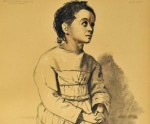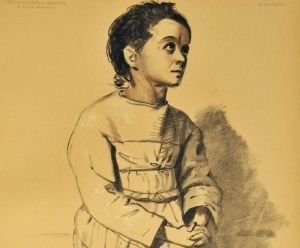
 Melancholia, B. BRamwell, Atlas of clinical medicine, 1892.
Melancholia, B. BRamwell, Atlas of clinical medicine, 1892.
The 19th century marks the beginning of alienism in France, a term which intersects with the beginning of psychiatry and the development of the asylum system. The number of mental health patients was constantly increasing : estimated at around 10,000 in 1834, it passed the 20,000 mark in 1850, then 50,000 around the 1880s. This continual increase took place within a new legislative context (the 1838 law) and the construction of specialised institutions, the most emblematic of which became the Hôpital Sainte-Anne in Paris. The asylum opened in 1867 on the initiative of the Prefect Haussmann to unblock the three existing sites in the capital - Bicêtre, La Salpêtrière and Charenton.
The population of the lunatic asylums was heterogeneous : the wings housed patients who were divided into ‘quiet’ and ‘furious’ patients, but also epileptics, alcoholics, and elders. The ills diagnosed were called melancholia, mania, delirium of persecution, idiocy, and general paralysis. But madness wasn’t the same according to the gender of the mental health patients. According to Jean-Etienne Esquirol (1772-1840), one of the founding fathers of French alienism : “weaker, more susceptible, more impressionable than men”, women are considered more naturally subject to melancholia, mania, and even hysteria. Man, a social person, is more threatened by general paralysis and alcoholism (a category built in the 1870s) which appeared as a national curse with the industrial and urban development.
What do the psychiatric records say about this apparently gendered representation of delirium (Yannick Ripa, La Ronde des folles, femmes, folie et enfermement au XIXe siècle, 1986) ? The law of 1838 which fixed the admission procedures in a context where accusation of abusives internments were abundant, made it compulsory to keep patient admission registers in which their marital status, symptoms and diagnosis justifying their hospitalisation are recorded. The study of these ‘registres de la loi’ kept in Sainte-Anne during the 1870s and 1880s show that the women’s recording modes differ from those of men in their delirium as reported by the doctors who examined them.
The delirium of male patients from Sainte-Anne mention war, politics, Paris to be rebuilt after the Commune, while those of women were focused on their bodies and the domestic sphere, or mysticism. If the male patient mentioned his wife or his partner, it was because he thought he heard voices telling him that she was behaving badly ; the woman was worried about her husband or her kids, she was afraid to make them perish, or to not recover. When, in his delirium of grandeur, a man suffering from general paralysis calls himself leader of all nations, the cleaning lady is dreaming about her ebony furniture. The male patient suffering from delirium of persecution thinks about his response to imaginary enemies that assail him ; the woman persecuted says she is a victim of gossip spread by neighbours or the priest. The melancholic man blames the others for his condition ; the female melancholic is reduced to a simple ‘disgust with life’ and summed up in her whining and scruples.
Passive, sad, guilt-ridden, the woman who entered the asylum during the 19th century was not, according to the alienists, a ‘dangerous madwoman’ : she had interiorized her inferior condition to the point of madness, or, in the case of many melancholics, her failure to conform herself to the advice of the century - to be a wife and mother. Beyond the scientific assessment of delirium, the emergence of psychiatry appeared to be full of the prejudices and values of its time. Strangely, it is only in alcoholic delirium that this gendered partition was missing : men and women were assailed by the same terrifying hallucinations. Is it for this reason that the woman who drinks suffers, more than man, the opprobrium of society ? The court records between 1880 and 1910 at Paris show a rather benevolent justice towards drunken or alcoholic men who kill their wives whereas heavier sentences were pronounced against the rare criminal women in the grip of alcohol (Ruth Harris, Murders and Madness, Medecine, Law and Society in the fin de siècle, 1989).
Read more in the dictionary : Puerperal insanity - Lypemania
Read the paper in French : Délire féminin
References :
Véronique Tison-Le Guernigou, Genre et délire dans les registres de l’Hôpital Sainte-Anne au XIXe siècle, Université du Maine, Faculté des Lettres, Langues et Sciences humaines, département d’Histoire, mémoire de Master sous la direction d’Hervé Guillemain, 2012.
Yannick Ripa, La Ronde des folles, femme, folie et enfermement au XIXe siècle, Aubier, 1986.
To quote this paper : Véronique Tison-Le Guernigou, "Female delirium" in Hervé Guillemain (ed.), DicoPolHiS, Le Mans Université, 2022.